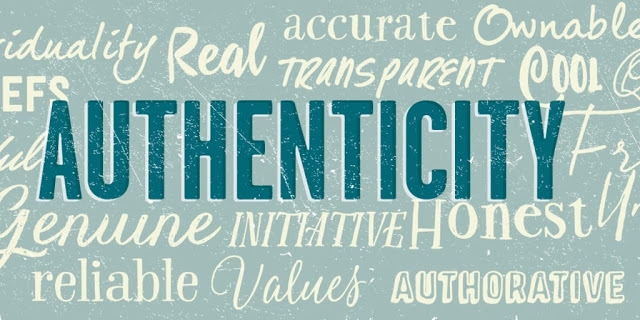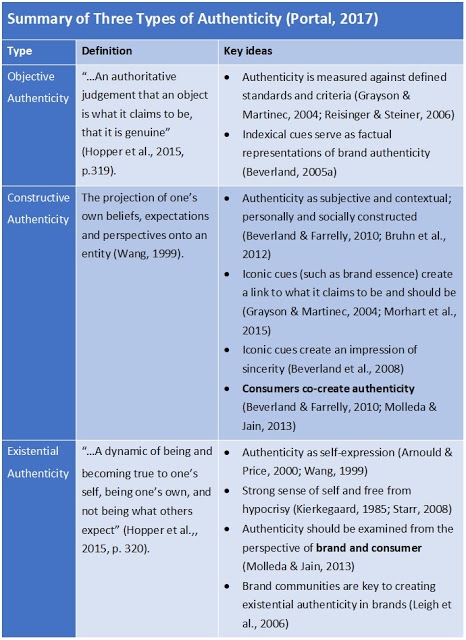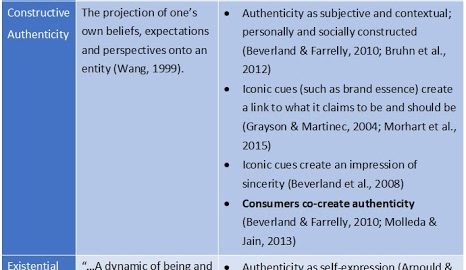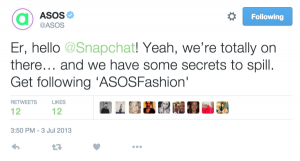What is Authenticity?
Authenticity has become somewhat of a “buzzword” over the past few years, and marketers have been scrambling to boast authenticity in marketing copy. For good reason, as recent data shows that 85% of shoppers consider authenticity an important aspect when making a purchasing decision.
Brand trust has declined, because of a contrast between the promises made by brands and what they deliver. As a result, consumers are becoming more doubtful of brand claims. Consumers do not trust brands that portray themselves as perfect, they instead want honesty and transparency.
“Consumers are faced with the challenge of finding authentic happiness in a world of mass-produced and hence inauthentic commodities.” (Jantzen, 2012)
There are multiple interpretations of authentic, such as: real, honest, truthful, ‘integrity, actual, genuine, essential, verified and sincere; andis the foundation for building trust.

A History of Authenticity
Music academics have explored authenticity, both with cultural performances and modern music such as folk, rock, rap and pop music. Authentic music performance is for the sake of self-enjoyment or ability in the art, whilst commercial endeavours are inauthentic. Being an artist for the sake of the arts rather than doing it to make commercial profit. Doing something solely for profit considered inherently inauthentic (why consumers often perceive brands as inauthentic).
There are two schools of thought: romanticism – where authenticity subscribes to tradition and cherishes the past, or a modernist approach to authenticity – grounded in experimentation and progress, and the belief true artists must move forward. In the arts, modernism is ‘Avant Garde’ – the French term for ‘in advance’ – describing any work or style considered in its own time to be radical, consciously breaking from earlier traditions.
The tourism literature also widely discusses authenticity, as it has become a primary concern for consumers seeking experiences. Consumers often research their destinations, and have a set of expectations, preferences and beliefs about what shall occur.
Objective Authenticity – Virtue
Objective authenticity is an assessment placed on or judgement placed on an object that is what it claims, and it is genuine. Such as a real Rolex watch, versus a counterfeit. A truthful representation of what they say they are. Consumers perceive an object as authentic based on their judgement of its sincerity. This perspective of authenticity has the notion that products produced by craftsmen primarily motivated by professionalism, tradition and love for what they are doing and not profit. Consumers seek uniqueness, originality, and genuineness. Marketing academics also describe this as “virtue” – the purity of motive to be an expert and being true to a set of morals.
“Multiple forms of authenticity are concurrently constructed in a single consumption context. This is in respect to the object or experience itself, the self, and the community.” (Leigh et al., 2006)
Multiple forms of Authenticity
Authenticity is not just a judgement of an object’s legitimacy, or a person’s intentions. The search for the authentic self is another important goal of consumption, as well as authentic experiences within consumption communities.

The authenticity of self – Control
Customers search for meaning through consumption – their desire for authentic brands is an identity creation activity. People want to feel like their ‘real’ selves, so immerse themselves in what they believe are authentic experience that reinforces a desired sense of self. The transferal of authenticity onto an object or experience is vital to an individual’s hopes of recognition as authentic, as this process validates the authenticator as well as the subject. The marketing literature also refers to this process as control – mastering one’s self and environment.
Consumers deliberately put themselves in situations conductive to this goal, called self-authentication. Self-authentication revitalises self-meaning, which enhances an individual’s well-being. It is an embodied sensation of knowing, to find one’s true self. It is a “doing process” felt within, a gateway to existential authenticity.
Existential authenticity exists an individual’s experience, rather than something measured or judged. Being true to oneself. The concept originates in philosophy and is common in tourism, where activities achieve a state of being. It can be based on an individual level or achieved in the presence of others through feeling like “real” community member, through collective sense of selves. Existential authenticity helps people feel more authentic and more freely self-expressed than in everyday life.
This collective sense of self strengthens social bonds between community members, an atmosphere where individuals may experience true self in presence of relevant others. Individuals obtain authenticity through sharing and communicating enjoyment with others.
Authenticity as Community – Connection
Customers seek authenticity in communities of consumption, often those that are based around a central brand. Collective gatherings supply a context for legitimisation, self-validation, and authenticity. A consumer’s collective identity significantly contributes to their individual quest for authenticity.
Authenticity dictates who is and is not part of the community. Authentic subculture members must have legitimate intentions and should embrace subcultural values as a lifestyle. An individual’s role performance in their subculture helps them self-authenticate through proving commitment to the community and genuine membership.
Actions perceived as breaking community norms result in a loss of authenticity.
“Authentic consumers embrace the subculture’s own hierarchies and definitions of what is authentic and legitimate.” (Leigh et al., 2006)
Can you fake authenticity? Its subjective nature
Individuals seek authenticity in a range of products, brands or experiences. Debates about authenticity within subcultures are common, usually concerned with and the nature of authentic membership and authentic behaviours. Being versus Doing.
Community members judge each other based on their intentions and acts. Members who adopt the accessories of a subculture without embracing its lifestyle and values considered as “doing” it — putting on a front to look the part. “Authentic” subculture members consider this as inauthentic, as their identity is not a reflection of true self. In contrast, authentic members are those that are engaged in “being.” By paying their dues over the years, subculture members earn authentic status.
But authenticity is subjective to each individual, dependent on their own interpretation. Intentions can seem authentic to some, an authentic to others. An individual’s opinion based their own associations based on their unique experience and knowledge. People match an object with the idea created by their beliefs and stereotypes. The subjectivity of an individual’s goals allows them to find authenticity and objects which others consider fake.
Consumers co-create the authenticity of a brand or experience and the meaning is dependent on their personal and unique understanding of what it means to be authentic.
“Authenticity’s association with reality, truth, and believability is subjective and allows the term to be used in different ways.” (Kolar & Zabkar, 2010)
Authenticity for Marketers
Authenticity is an important concept for marketers to understand, as consumers are more likely to trust authentic brands. First, how do brands communicate their own authenticity? To enhance feelings of authenticity, marketers of brands relating to products or services should aim to come across as more “human” in advertising and promotion. Thus, enabling customers to recognise the characteristic values of the brand. Customers associate warmth, competence and trust with authenticity.
Second, consumers want to feel authentic. A goal of the consumption of products, brands and experiences is self-authentication, to enhances peoples’ well-being.
“Brand authenticity is a subjective evaluation of genuineness ascribed to a brand by a consumer.” (Napoli et al., 2014)
Marketers must adapt their approach for their specific brand in specific contexts and be aware of their customers unique interpretation of authenticity. It is important to understand the intricacies of the consumption communities related to their product, service or industry before an attempt to enhance perceptions of authenticity. Brand community is everywhere, some examples are Facebook groups, YouTube channels, blogs, and forums. Marketers should engross themselves in these communities to gain an understanding of what is authentic.
“Trust (like authenticity) is associated with consistency, competence, honesty, fairness, responsibility, helpfulness and benevolence.” (Morgan & Hunt, 1994)
Despite consumers having different goals, experiences, and expectations of what is authentic, one thing stays consistent – the desire for something real, true, and genuine. If customers perceive a brand as authentic, then they find them more trustworthy. People who trust you are far more likely to do business with you.
Business & Finance Articles on Business 2 Community
(59)
Report Post







